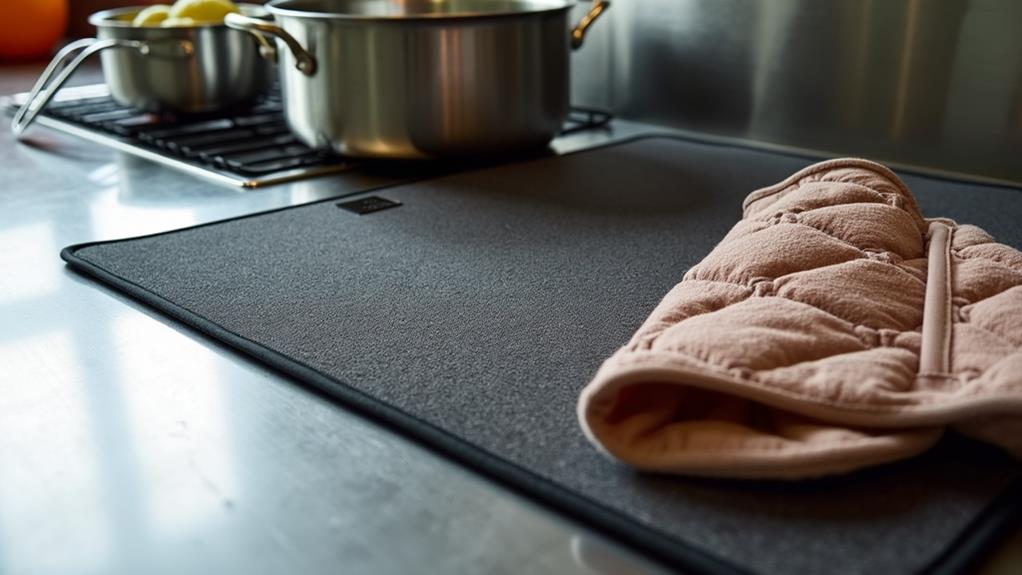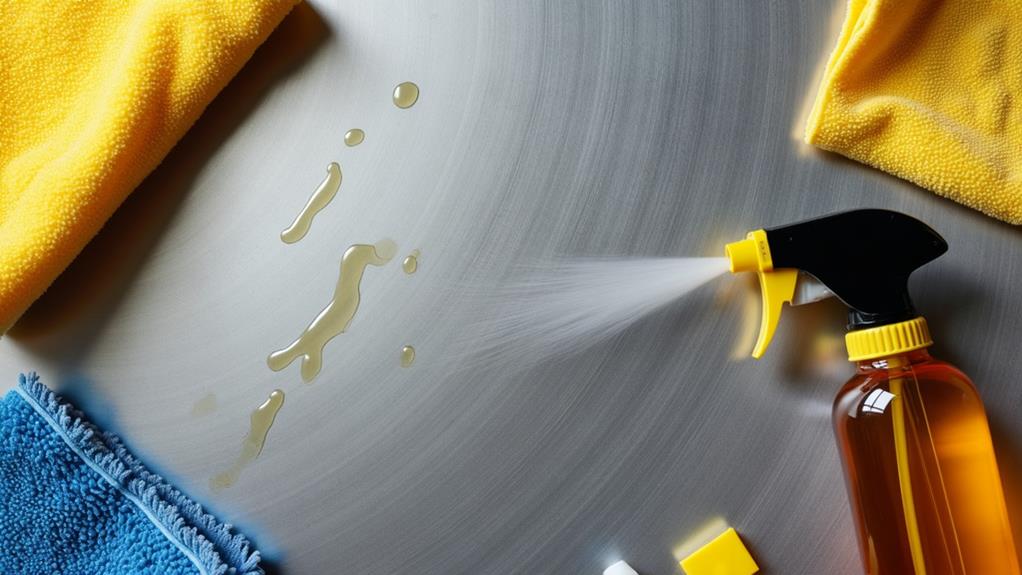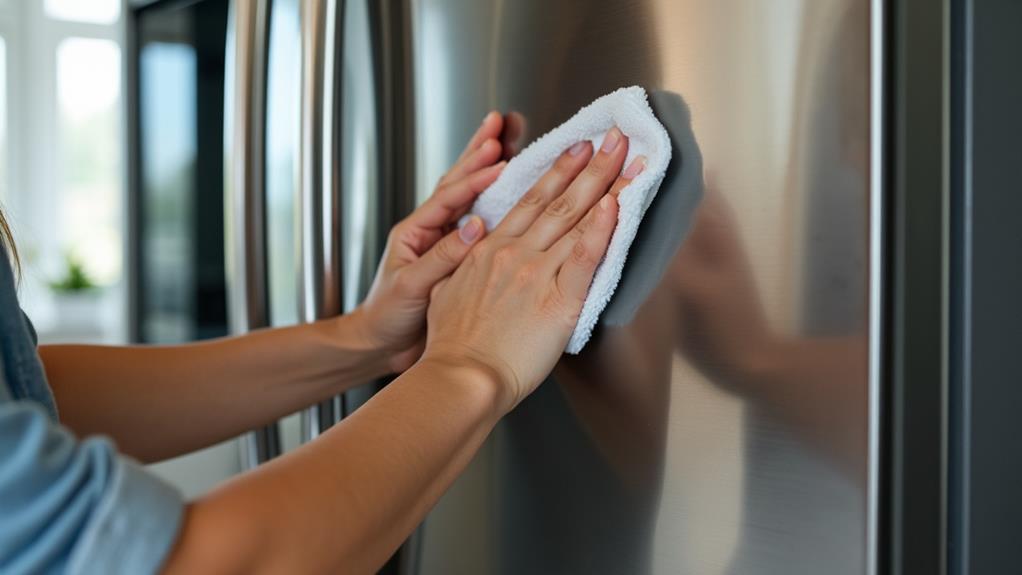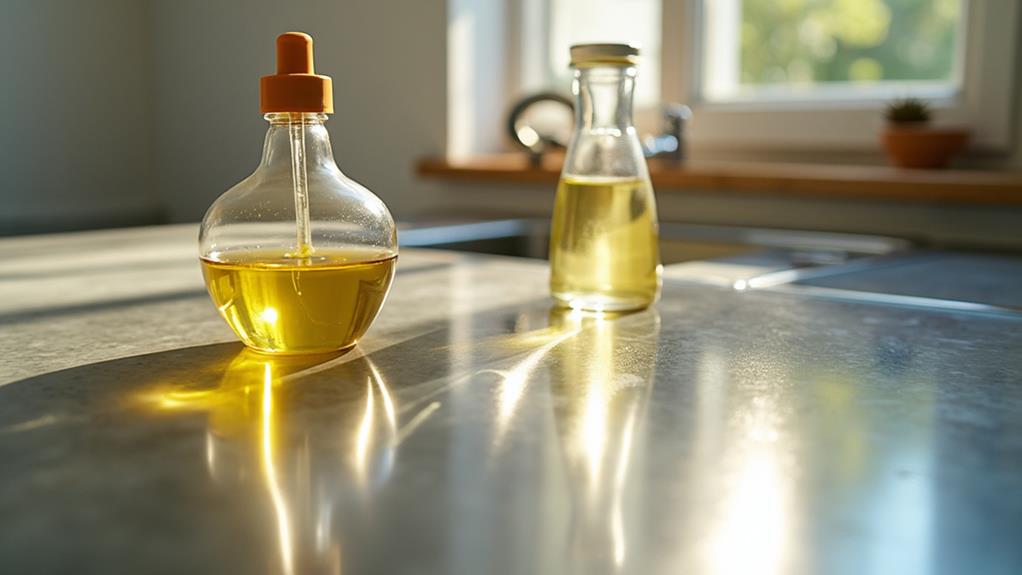How to Safely Remove Adhesive Residue From Stainless Steel
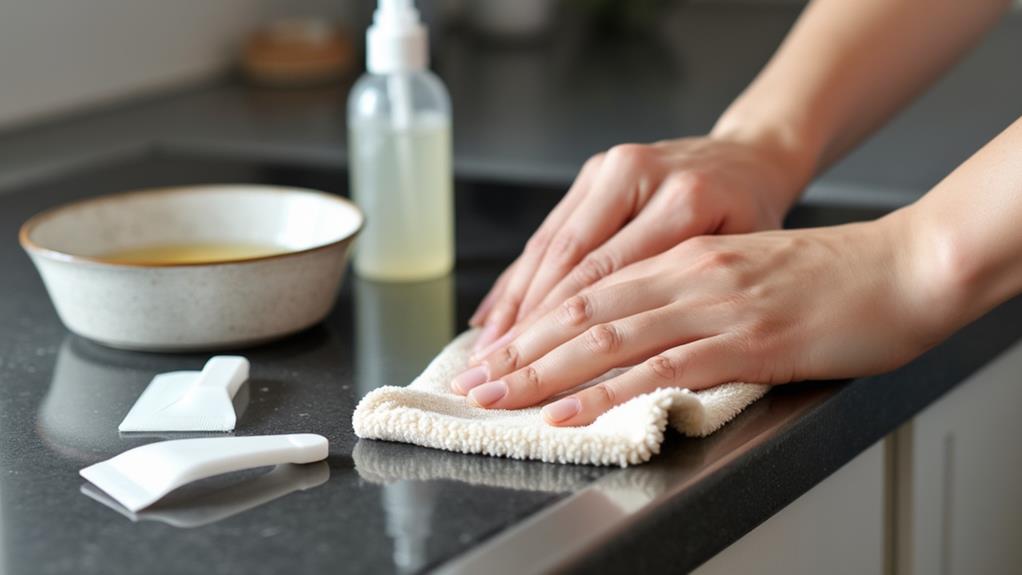
You can safely remove adhesive residue from stainless steel by starting with warm soapy water and a soft cloth. If that doesn't work, try soaking a cloth in white vinegar or rubbing alcohol and gently rub the sticky area. For more stubborn residue, use a baking soda paste or commercial adhesive remover. Always test on a small, inconspicuous area initially to avoid damage, and use a plastic scraper to prevent scratches. Finish by rinsing with warm, soapy water and drying with a microfiber cloth. There's even more you can uncover about keeping your stainless steel spotless.
Gather Necessary Supplies
When you're ready to tackle adhesive residue, having the right supplies on hand is crucial. Start by identifying the adhesive types you're dealing with. Common types include stickers, tape, and glue. Each may require different tools or solvents for effective removal.
First, gather the basics: a soft cloth, plastic scraper, and a mild solvent like rubbing alcohol or vinegar. These items help remove the adhesive without damaging the surface. For tougher residues, consider commercial adhesive removers. They're specially formulated to break down sticky substances.
Next, guarantee surface protection. Stainless steel, while durable, can be scratched or tarnished if you're not careful. Use a plastic scraper instead of a metal one to avoid scratches. Always test solvents on a hidden area to verify they don't discolor or damage the finish.
You may also need gloves to protect your hands from harsh chemicals and a mask if you're working in a poorly ventilated area. With these supplies ready, you're well-prepared to remove adhesive residue effectively and safely. Remember, the right tools and materials make all the difference in preserving the integrity of your stainless steel surfaces.
Test a Small Area
Before you start removing adhesive residue, it's vital to test a small area initially. This step guarantees that the method you choose won't damage your stainless steel surface. Adhesive types vary, and some can be more stubborn than others. Testing helps you determine the best approach without risking the appearance of the entire surface.
Begin by selecting an inconspicuous spot on the stainless steel. Apply a small amount of your chosen adhesive remover or cleaning solution. Regardless of whether you're using a commercial adhesive remover, rubbing alcohol, or a homemade concoction, understanding surface compatibility is significant. Let the solution sit for a few minutes to gauge its effect.
After allowing it to sit, gently wipe the area with a soft cloth. Check for any discoloration, dullness, or other adverse reactions. If there's no damage, you can proceed with confidence on the larger area. If you notice any negative effects, reconsider the adhesive remover and try a different one.
Warm Soapy Water
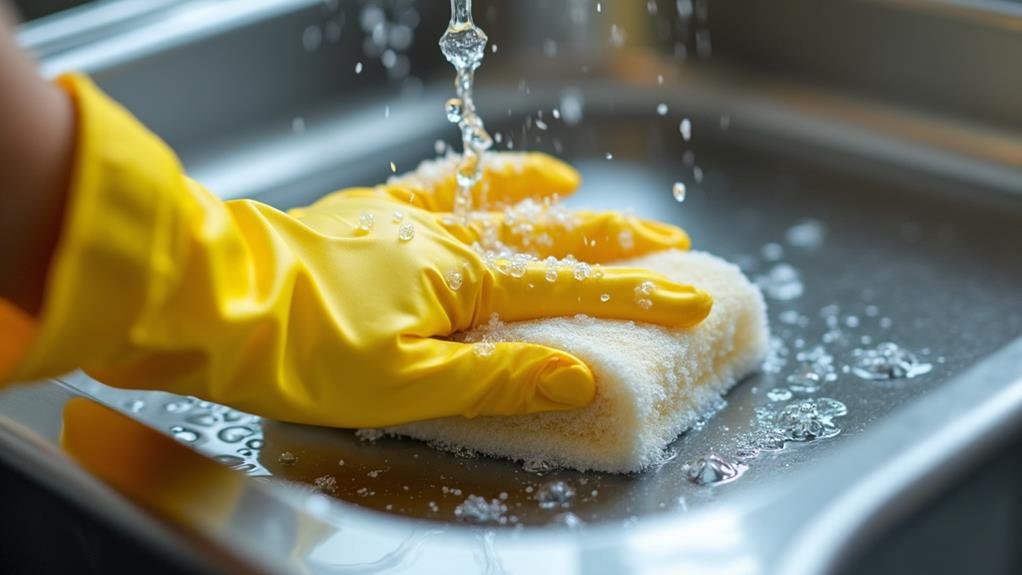
A simple and effective method to start removing adhesive residue is using warm soapy water. This approach is gentle and helps maintain surface protection while tackling diverse adhesive types. Begin by filling a bowl with warm water and adding a few drops of mild dish soap. Stir to create a soapy solution.
Dip a soft cloth or sponge into the soapy water and wring out excess liquid to avoid drips. Gently rub the adhesive residue, applying light pressure to prevent scratching the stainless steel. The warmth of the water softens the adhesive, making it easier to remove. If you're dealing with stubborn residue, you might need to soak a cloth in the solution and let it sit on the sticky area for a few minutes.
Remember, different adhesive types might react differently to warm soapy water. While this method is generally safe, always test a small area initially to verify no damage. This step is vital for surface protection, confirming your stainless steel remains unmarred.
After removing the residue, rinse the area with clean water and dry it with a soft towel to prevent water spots. If any adhesive remains, consider trying other methods.
Use White Vinegar
For a natural and effective way to tackle adhesive residue, try using white vinegar. This common household item is not only affordable but also adaptable. One of the top vinegar benefits is its ability to break down sticky substances, making it an excellent choice for removing different adhesive types from stainless steel surfaces.
Start by soaking a clean cloth in white vinegar. Apply the soaked cloth directly to the adhesive residue. Let it sit for a few minutes to allow the vinegar to penetrate and break down the adhesive. Distinct adhesive types may require different soaking times, so be patient. After soaking, gently rub the area with the cloth. You'll notice the residue starting to lift off.
If the adhesive is particularly stubborn, you may need to reapply the vinegar and repeat the process. Using white vinegar not only helps remove the residue but also guarantees that you're not introducing harsh chemicals to your stainless steel. Moreover, vinegar benefits include its natural disinfectant properties, leaving your surface clean and shiny.
Once the adhesive is removed, wipe the area with a damp cloth to remove any remaining vinegar. Dry the surface with a paper towel or soft cloth.
Baking Soda Paste
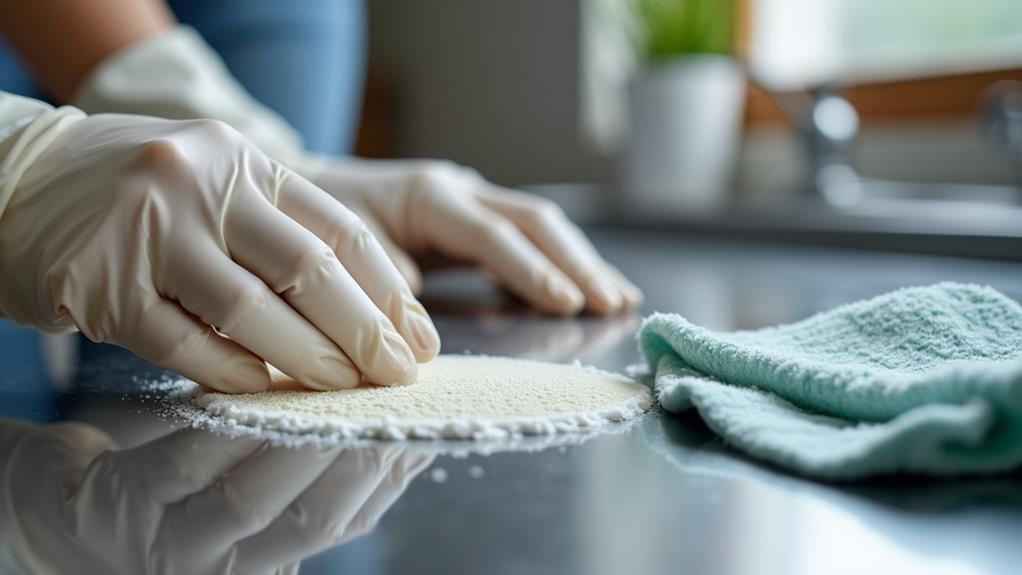
Another effective method for removing adhesive residue involves using a baking soda paste. Baking soda is a natural, non-toxic cleaner that's gentle on stainless steel. One of the main baking soda benefits is its abrasive properties, which help in scrubbing away stubborn residue without scratching the surface.
To create the paste, mix three parts baking soda with one part water until you achieve a thick consistency. Apply the mixture directly onto the adhesive residue. Using a soft cloth or sponge, gently rub the area in a circular motion. This technique helps lift the adhesive without damaging your stainless steel.
After scrubbing, let the paste sit for about five minutes. This waiting period allows the baking soda to break down the adhesive more effectively. Once the time is up, wipe away the paste with a damp cloth. You'll notice the adhesive residue coming off easily. If any residue remains, repeat the process until the surface is clean.
Among adhesive removal techniques, baking soda paste stands out for its simplicity and effectiveness. Plus, it's a common household item, making it a convenient option. Give this method a try, and your stainless steel will look as good as new.
Rubbing Alcohol
Rubbing alcohol, often readily available in most households, proves to be an excellent solution for removing adhesive residue. It's effective because its solvent properties break down the sticky substances left behind by adhesives. Grab a clean cloth or cotton ball and soak it in rubbing alcohol. Gently rub the affected area, and you'll notice the adhesive residue lifting away. Be certain to use moderate pressure to avoid scratching the stainless steel surface.
Among rubbing alcohol uses, removing adhesive residue is one of the most practical. Adhesive residue effects can leave your stainless steel looking dirty and unkempt, but a bit of rubbing alcohol can restore its original shine. It's also quick-drying, so you won't have to worry about any lingering wet spots.
After you've removed the residue, wipe the area with a damp cloth to remove any remaining alcohol, then dry thoroughly with a clean towel. This guarantees no streaks or marks are left behind. Using rubbing alcohol not only saves time but also helps maintain the pristine condition of your stainless steel items. So next time you face stubborn adhesive residue, reach for your rubbing alcohol and watch the magic happen.
Commercial Adhesive Removers
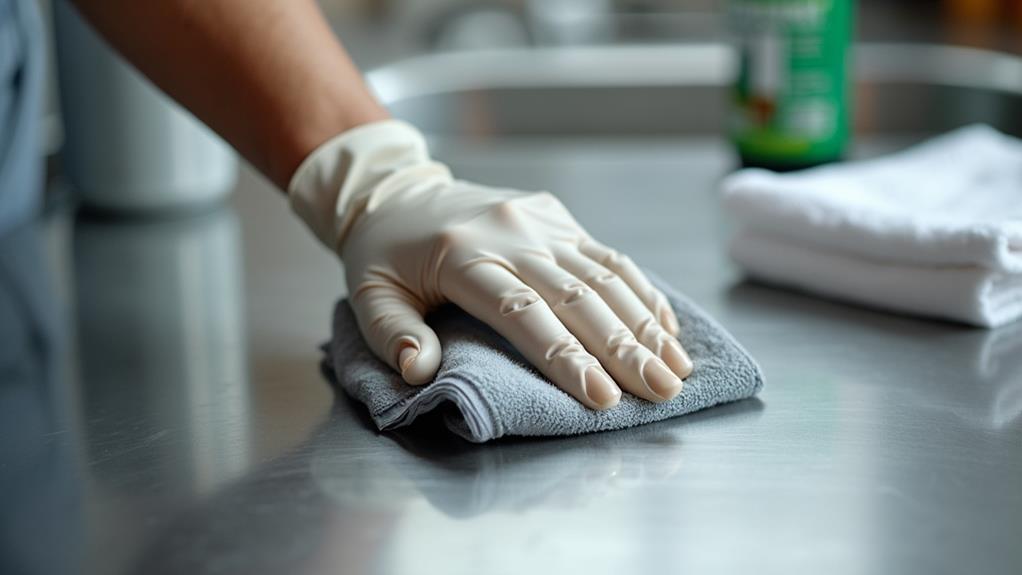
If rubbing alcohol doesn't quite do the trick, you might find commercial adhesive removers to be a more potent solution. These products are designed specifically to tackle stubborn adhesive residue and can make the job much easier. However, it's crucial to choose the right one and utilize it safely.
When selecting a commercial adhesive remover, consider these factors:
- Eco friendly options: Some removers are made with natural ingredients that are less harmful to the environment. Look for labels that indicate eco friendly formulations.
- Safety precautions: Always read the product's instructions and warnings. Many commercial removers contain strong chemicals, so you'll want to use gloves and guarantee proper ventilation.
- Compatibility: Make sure the remover is safe for stainless steel. Some products can cause discoloration or damage to the metal surface.
To use a commercial adhesive remover, apply a small amount to a clean cloth and gently rub the adhesive residue. Let it sit for a few minutes to break down the adhesive, then wipe it off with another clean cloth. Always follow up by washing the area with mild soap and water to remove any remaining product.
Final Rinse and Dry
Once you've removed the adhesive residue, it's essential to give the area a final rinse to guarantee no remnants of the remover are left behind. Start by using warm, soapy water for the final rinsing techniques. A mild dish soap works best. Dampen a soft cloth or sponge, and gently wipe down the stainless steel surface. This step guarantees that any remaining adhesive remover, which could potentially damage the steel or leave streaks, is completely washed away.
After rinsing, it's time to focus on drying methods. Use a clean, dry microfiber cloth to wipe down the stainless steel. Microfiber is ideal because it doesn't leave lint behind and absorbs moisture effectively. Make sure to dry the surface thoroughly, as leaving water to air dry can cause water spots. For an extra shine, you can buff the area with another dry microfiber cloth, moving in the direction of the steel's grain.

